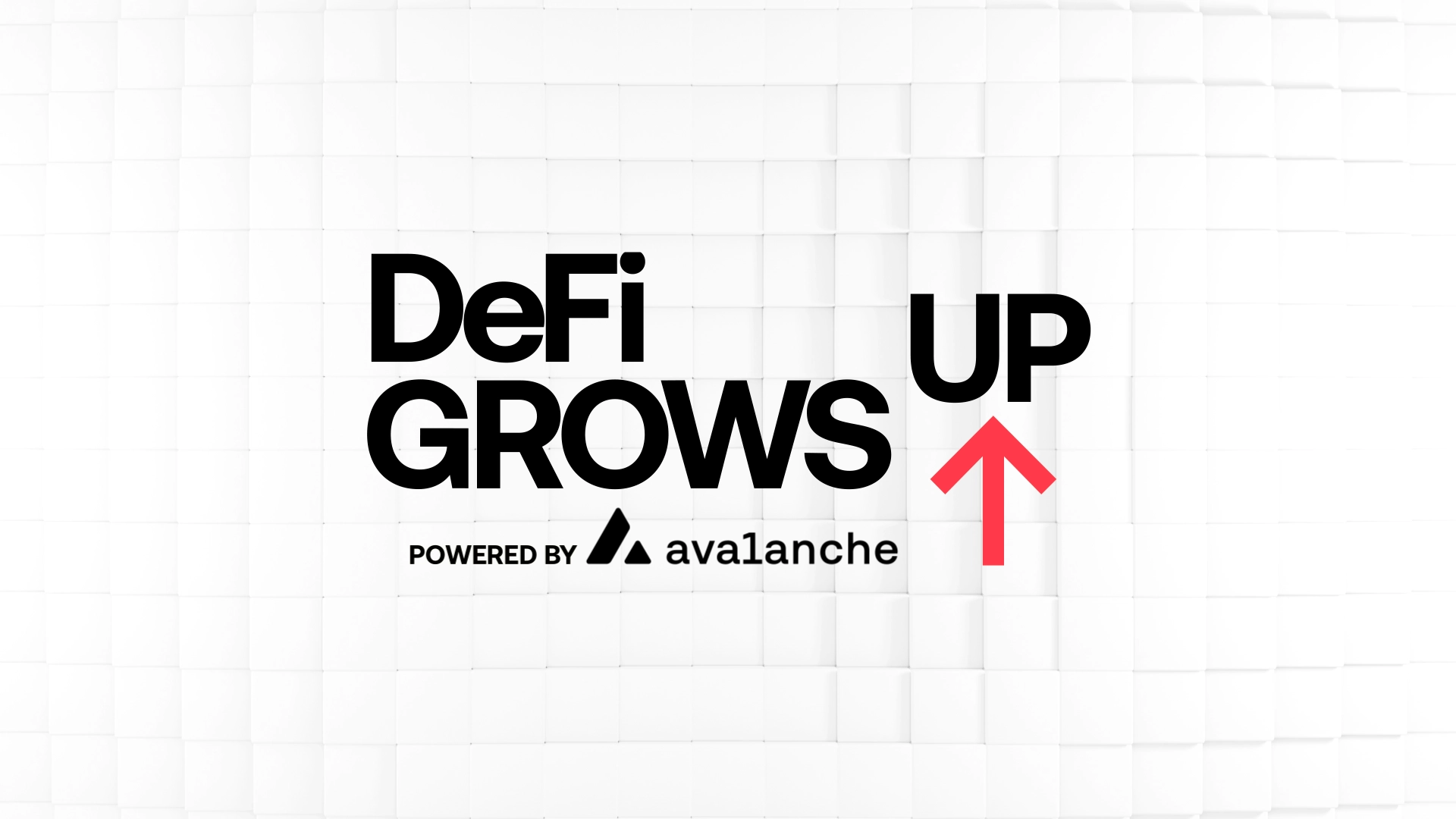DeFi Grows Up: RWAs, Scalable Liquidity, and Institutional Access on Avalanche
DeFi Grows Up: RWAs, Scalable Liquidity, and Institutional Access on Avalanche
Apr 30, 2025 / By Avalanche / 6 Minute Read

From experimentation to infrastructure, Avalanche is powering DeFi’s next chapter.
The early days of DeFi were chaotic but formative, defined by experimentation, outsized yields, and a lack of structure. Protocols launched anonymously, APYs often exceeded 100%, and users chased returns with little regard for risk. But beneath the surface of that frenzy was something fundamental: the desire for an open, permissionless financial system.
Today, the foundations of that system are taking shape. What began as a speculative playground is maturing into a credible, scalable, and increasingly institutional financial stack. This evolution requires performant infrastructure, composable design, and low-latency execution.
That’s where Avalanche comes in. Built for scale, speed, and flexibility, Avalanche offers sub-second finality, high-throughput consensus, and full EVM compatibility, making it well-suited for modern DeFi applications. Its architecture supports everything from dynamic trading strategies to programmable stablecoins, while customizable Layer 1s (L1s) allow institutions to deploy tailored, compliance-aware environments.
As DeFi grows up, it needs more than hype cycles. It needs a foundation. Avalanche is helping provide it.
Stablecoins: Not Just Money. Monetary Infrastructure
Stablecoins have evolved from simple trading tools to multi-functional financial instruments. On Avalanche, this transformation is led by teams building for scale, utility, and integration. The network supports over $2.12B in stablecoin market cap across diverse assets, with over 2.5M holders actively participating in the ecosystem. This growing base reflects the role of stablecoins not just as a medium of exchange but as a foundational infrastructure for payments, yield, and cross-border liquidity.
Avant launched avUSD, a native Avalanche stablecoin optimized for composability across DeFi, and recently hit a $40M TVL milestone. It pairs with savUSD, a yield-bearing variant that taps into DeFi-native strategies like cash-and-carry trades and real-world assets (RWAs). These assets are designed for institutional-grade access, without leaving the Avalanche ecosystem.
Agora’s AUSD drives capital efficiency and democratized yield access through permissionless infrastructure. With a market cap of over $81 million and $35.2 million deployed on Avalanche, AUSD ranks among the top five stablecoins by volume on the network, serving as a gateway for protocols, funds, and institutions to deploy native USD capital at scale.
Other stablecoins are regional by design. XSGD from StraitsX unlocks APAC liquidity. BRZ, issued by Transfero, connects LATAM markets to onchain finance. EURC, a Euro-backed token from Circle, brings MiCA-compliant Euro liquidity into the Avalanche ecosystem. Each expands Avalanche’s reach into real-world payments, cross-border commerce, and FX pair trading.
Institutional players like Nonco are expanding the stablecoin ecosystem with FX-focused infrastructure built directly on Avalanche. FX On-Chain's platform automates conversions between USD-backed stablecoins such as USDC, USDT, and AUSD and local currency-backed assets, creating efficient, compliance-grade rails for payments, remittances, and treasury operations. By eliminating off-chain friction, FX On-Chain enables businesses to move capital seamlessly between fiat and DeFi ecosystems.
Trading: A New Stack for Capital Efficiency
Avalanche’s low-latency, high-throughput design makes it the ideal home for a new generation of trading infrastructure.
Vertex Protocol merges spot, perps, and lending into a unified platform. With cross-margin support, sub-second execution, and real-time strategy deployment, Vertex has already processed over $1B in trades on Avalanche.
Euler Finance brings composable lending to the ecosystem through risk-isolated markets. This design enables users to construct and customize lending strategies while maintaining a secure and modular system architecture. Euler surpassed $190M in deposits just two weeks after launching on Avalanche, marking one of the network's strongest DeFi lending protocol debuts to date.
Balancer V3 transforms liquidity provision from passive LPing into programmable financial infrastructure. With boosted pools and smart routing, users can deploy dynamic portfolios and structured yield strategies on Avalanche.
DeUSD by Elixir is a decentralized stablecoin powered by delta-neutral strategies and RWAs. On Avalanche, its active rebalancing model benefits from real-time execution, which is critical for maintaining peg stability while enabling yield.
Real-World Assets: From Narrative to Core Collateral
RWAs are becoming the clearest on-ramp for institutional capital. Avalanche currently supports over $163 million in tokenized RWA volume across 24 assets, reflecting the growing adoption of onchain financial instruments within the ecosystem.

RWA On Avalanche overview
Backed Finance brings traditional equities like SPY and COIN onchain under Swiss regulatory frameworks, offering fully backed, composable assets that users can LP, collateralize, or integrate into DeFi strategies just like native tokens.
OpenTrade connects fixed-income markets to DeFi by tokenizing U.S. Treasury bills and institutional credit products, opening access to stable, real-world cash flows without relying on wrappers or synthetic instruments.
Institutional players are also scaling access to tokenized money market funds. BlackRock’s BUIDL, issued via Securitize, brings U.S. Treasury ownership onchain. On Avalanche, BUIDL can be held in a wallet and used as DeFi collateral through sTokens, marking the first time a BlackRock fund is natively integrated into DeFi.
Building further, WisdomTree has deployed 13 SEC-registered tokenized funds on Avalanche, spanning equities, money markets, and asset allocation products. These aren’t experimental wrappers; they are fully compliant investment vehicles backed by a $100B+ asset manager.
Beyond traditional finance, innovation is reaching new asset classes. Re is bringing the reinsurance market onchain, tokenizing reinsurance premiums to create a non-correlated yield source for DeFi that avoids circular borrowing structures and inflationary incentives.
Each of these projects uses Avalanche’s infrastructure to bring compliance, scale, and composability to asset classes traditionally locked in TradFi silos.
Liquid Staking: The Capital Layer of Avalanche DeFi
With over $245 million staked across providers like Benqi, GoGoPool, and Yield Yak, liquid staking tokens (LSTs) like sAVAX, ggAVAX, and yyAVAX are becoming core collateral for Avalanche’s evolving DeFi ecosystem.
These LSTs aren’t just passive yield instruments. On Avalanche, they unlock lending, margin trading, vault strategies, and cross-chain liquidity flows, turning staked assets into active components of capital markets.
Platforms like Upshift simplify how users deploy staked assets, offering managed vaults that automate market-making, optimize yields, and enable single-sided deposits. Beyond vaults, Upshift is building a cross-chain prime brokerage, allowing users to borrow, lend, trade, and settle across chains with liquid-staked collateral, including OTC perps and structured swaps.
Meanwhile, with Suzaku, users can restake their AVAX LSTs to help secure emerging Avalanche L1s, earning additional rewards while maintaining liquidity. This mirrors restaking models emerging elsewhere but benefits from Avalanche’s native composability, faster finality, and lower costs.
Liquid staking on Avalanche isn’t just about passive rewards, it’s becoming a core capital layer for DeFi’s next generation.
Closing Thoughts
DeFi has outgrown its speculative roots. What comes next is infrastructure, interoperability, and integration with real-world finance. Avalanche is uniquely enabling this shift with speed, scale, and modularity. From programmable stablecoins and automated trading strategies to tokenized funds and restaking infrastructure, the building blocks of institutional DeFi are already here.




